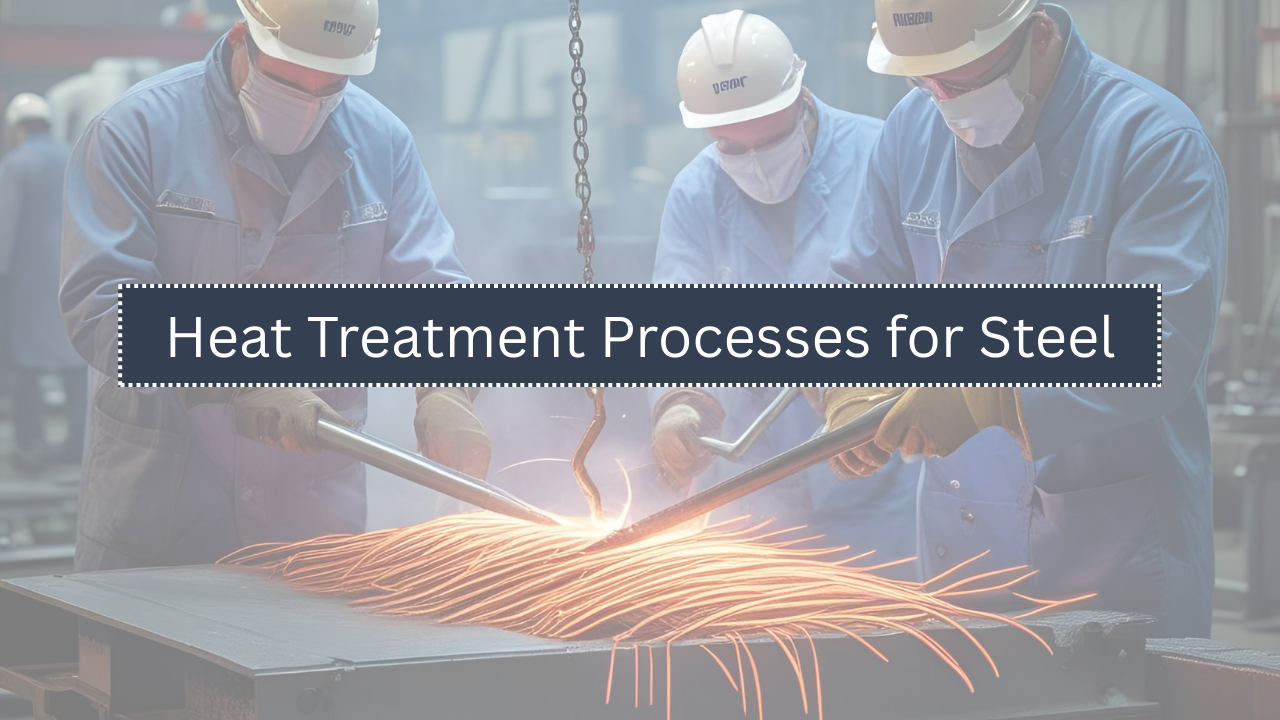Steel, a widely used metal in industries, becomes more useful when treated through heat. Heat treatment changes its internal structure, making it stronger, softer, harder, or more flexible based on the requirement. The most common heat treatment processes used for steel are annealing, quenching, and tempering. Each process has a specific purpose and is used depending on the final use of the steel part.
This article explains these three important processes, their working steps, advantages, and applications.
What is Heat Treatment?
Heat treatment is a method used to improve the physical and mechanical properties of steel. It involves heating the metal to a certain temperature and then cooling it at a controlled rate.
Key Objectives of Heat Treatment:
- Increase strength
- Improve hardness
- Enhance ductility
- Reduce internal stress
- Improve machinability
- Refine grain structure
1. Annealing Process
Annealing is a heat treatment method that softens steel. It improves ductility and removes internal stress caused by processes like machining, welding, or cold working.
Steps Involved in Annealing:
- Heating the steel slowly to a particular temperature.
- Soaking the metal at that temperature for a fixed period.
- Cooling the metal slowly, usually inside the furnace (known as furnace cooling).
Purpose of Annealing:
- To soften hard steel
- To improve machinability
- To remove internal stresses
- To enhance ductility
Types of Annealing:
| Type | Purpose | Cooling Method |
|---|---|---|
| Full Annealing | Maximum softness and ductility | Furnace cooling |
| Process Annealing | Stress relief for mild steel | Air or furnace cooling |
| Spheroidizing Annealing | Improves machinability of high-carbon steel | Very slow cooling |
Advantages of Annealing:
- Makes steel easier to cut and shape
- Improves electrical and magnetic properties
- Increases flexibility and elongation
Applications of Annealing:
- Electrical cables
- Automotive parts
- Sheet metal for appliances
- Pipes and tubes
2. Quenching Process
Quenching is a method used to harden steel. After heating to a high temperature, the steel is quickly cooled in a liquid such as oil, water, or brine. This rapid cooling increases the steel’s hardness but makes it brittle.
Steps Involved in Quenching:
- Heating the steel above its critical temperature.
- Holding the temperature for a short time.
- Rapidly cooling the steel in a quenching medium (water, oil, or salt bath).
Common Quenching Media:
| Medium | Cooling Rate | Effect on Steel |
|---|---|---|
| Water | Very fast | High hardness, high stress |
| Oil | Moderate | Balanced hardness and toughness |
| Brine (saltwater) | Faster than water | Extremely hard, risk of cracking |
| Air | Slow | Used for air-hardening steels |
Purpose of Quenching:
- Increase hardness
- Improve wear resistance
- Prepare steel for tempering
Advantages of Quenching:
- Steel becomes extremely hard
- Suitable for cutting tools and knives
- Wear resistance is greatly improved
Disadvantages of Quenching:
- Steel becomes brittle
- Risk of warping or cracking
- Generates internal stresses
Applications of Quenching:
- Knives and blades
- Drill bits and chisels
- Gears and shafts
- Cutting tools
3. Tempering Process
Tempering follows quenching. Since quenching makes steel too hard and brittle, tempering reduces that brittleness while maintaining strength. It involves reheating the quenched steel to a lower temperature and then cooling it again at a slower rate.
Steps in Tempering:
- Reheating the quenched steel to a temperature below the critical point (150°C–650°C).
- Holding the temperature for a specific time.
- Cooling the steel in air, water, or oil.
Purpose of Tempering:
- Reduce brittleness caused by quenching
- Improve toughness
- Balance hardness and ductility
Effects of Tempering at Different Temperatures:
| Temperature Range (°C) | Result on Steel |
|---|---|
| 150–250 | High hardness, low toughness |
| 300–400 | Good balance between hardness and ductility |
| 500–650 | Maximum toughness, reduced hardness |
Advantages of Tempering:
- Reduces internal stress
- Improves impact strength
- Enhances ductility
Applications of Tempering:
- Automotive springs
- Cutting tools
- Structural steel parts
- Machine components
Comparison: Annealing vs Quenching vs Tempering
| Aspect | Annealing | Quenching | Tempering |
|---|---|---|---|
| Purpose | Soften steel | Harden steel | Reduce brittleness after quenching |
| Temperature | Below critical point | Above critical point | Below critical point |
| Cooling Method | Slow (furnace or air) | Fast (water, oil, brine) | Moderate (air, oil, or water) |
| Result | Soft, ductile, stress-free steel | Hard, brittle steel | Tough, strong, and less brittle |
| Application Areas | Wires, sheets, pipes | Blades, tools, machine parts | Springs, tools, gears |
Factors Affecting Heat Treatment Results
Several factors influence how steel reacts to heat treatment:
- Type of steel (carbon content)
- Size and shape of the steel object
- Heating rate and soaking time
- Cooling rate and medium used
- Atmosphere during treatment (air, vacuum, inert gas)
Final Thoughts
Heat treatment plays a key role in shaping the performance of steel products. Annealing softens steel and relieves stress. Quenching hardens steel but makes it brittle. Tempering balances hardness with toughness after quenching. These three processes allow engineers and manufacturers to create steel components that perform efficiently under various industrial conditions.
Understanding these heat treatment processes helps in selecting the right type of steel and treatment method for applications ranging from delicate electronic parts to heavy-duty machinery.

